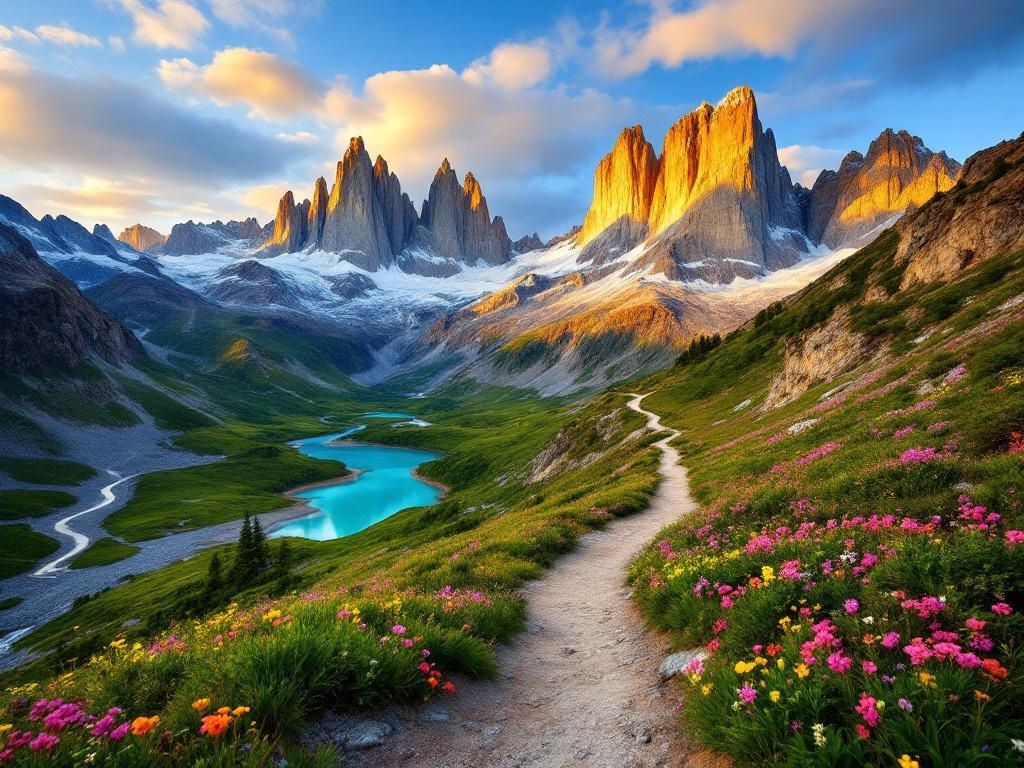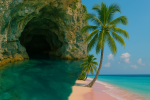Hiking in Torres del Paine National Park
Experience the breathtaking beauty of Torres del Paine National Park in Chile, a year-round destination for adventure seekers. Trek the iconic W Trek, a self-guided favorite available from October to April, or challenge yourself with the complete “O Circuit.” Plan your Patagonian adventure now and discover a world of stunning granite peaks, glaciers, and diverse wildlife. Learn how to book accommodations, secure park tickets online, and choose the best trekking route for your skill level. Start planning your unforgettable journey today!
Important information

- Book park tickets and accommodations (refugios or campsites) online in advance, especially during peak season (October to April).
- The W Trek (5 days) and the O Circuit (7-9 days) are popular treks, with the W Trek being a good option for various skill levels.
- Prepare for unpredictable weather and pack essential gear, including sturdy hiking boots, rain gear, a headlamp, and navigation tools.
- Independent trekking offers flexibility and lower costs ($800-$1500), while guided treks ($2500-$5000) provide support and expertise.
- Buses from Puerto Natales provide access to the park. Food and gear can be purchased in Puerto Natales or designated spots inside the park.
Introduction to Hiking in Torres del Paine National Park
Torres del Paine National Park in Chile welcomes visitors year-round, offering breathtaking views of the Patagonian landscape. Trekking is a popular activity, with routes like the W Trek and the O Circuit. The self-guided W Trek is a favorite, available from October to April. Before you travel, make sure you have the necessary visa or permits. Check the latest entry requirements here.
Travel and Logistics
Arrange your transportation, buses from Puerto Natales are a common option.
Secure your park tickets online in advance.
Book your accommodations (refugios or campgrounds) inside the park well ahead of time, especially if traveling during peak season.
Pack essential trekking gear, including sturdy hiking boots, rain gear, and a headlamp.
Purchase food supplies in Puerto Natales or at designated locations within the park.
Carry plenty of water, as access to drinking water may be limited.
Getting to Torres del Paine: Bus Transport from Puerto Natales
Traveling from Puerto Natales to Torres del Paine National Park is easy, thanks to regular bus services provided by Buses Gómez and Buses Maria José. The two-hour journey starts at the Puerto Natales bus station and usually ends at Laguna Amarga, the park’s main entrance. Some buses also go deeper into the park, providing direct access to places like Pudeto and Hotel Las Torres.
Park Entrance Tickets and Fees: Booking Online
Purchase Torres del Paine National Park tickets online in advance, as they are no longer sold at the entrance. The price depends on the length of your stay.
Popular Trekking Routes
Patagonia’s famous five-day W Trek offers a spectacular view of the region’s highlights.
For a more demanding adventure, the Paine Massif Circuit, or “O Circuit,” provides a comprehensive loop, typically completed in eight to nine days.
Alternatively, extending the W Trek with the challenging John Gardner Pass adds another two to four days, creating a seven- to nine-day journey.
W Trek: A Highlight of Patagonia
The W Trek in Torres del Paine National Park is famous for its stunning Patagonian scenery and accessible trails, making it a highlight of the W Circuit. The diverse landscapes cater to all skill levels, from the incredible beauty and diverse wildlife of the French Valley trail to the challenging climb to the Base of the Towers, rewarded by panoramic vistas.
Iconic granite towers, breathtaking glaciers, and unforgettable views further enhance the trekking experience. This Patagonian gem offers a truly remarkable adventure for nature enthusiasts of all abilities.
Paine Massif Circuit: The O Circuit
The challenging O Circuit, a complete loop around the Paine Massif, takes 7–8 days and immerses hikers in Patagonia’s diverse landscapes. The demanding trek rewards adventurers with breathtaking views and stunning vistas at every turn, forging a deep connection with nature.
John Gardner Pass: A Challenging Section
The challenging John Gardner Pass, nestled high in Torres del Paine National Park, connects the Grey Glacier and Paine Grande areas. Hikers tackling its steep inclines are rewarded with breathtaking panoramas of mountains, glaciers, and valleys. This pass is a key feature of the “O Circuit,” a longer and more demanding trek than the “W Trek,” requiring more time and a higher level of fitness. Be prepared for unpredictable weather, which can significantly impact crossing conditions. Careful planning ensures a safe and memorable experience.
Trail Details and Difficulty Levels
The Las Torres Sector Trail presents a moderately challenging hike with diverse scenery and stunning vistas, perfect for those seeking a rewarding trek.
Experienced hikers looking for a true challenge should consider the difficult Grey Sector to Paine Grande Sector Trail. Careful planning is essential due to its length and varied terrain.
Valle Francés, a more demanding route, requires fitness and sturdy boots, but the payoff is spectacular waterfalls and hanging glaciers.
The easy Laguna Azul to Laguna Cebolla Viewpoint Trail offers accessible beauty for all levels, with stunning views of the Paine massif and potential wildlife sightings.
Trail between Las Torres Sector: Moderate Route
This 13.5 km point-to-point trail in the Las Torres sector presents a moderate challenge, making it a good option for hikers of varying experience levels. Seasoned trekkers will appreciate the route, while those newer to hiking can still comfortably complete it.
Trail through Valle Francés: A Difficult Trail
The challenging 3.7-km Valle Francés trail in Torres del Paine National Park demands a good fitness level for the round trip. This tough route attracts experienced hikers seeking adventure.
Trail between Grey Sector and Paine Grande Sector: Difficult Route
The challenging 22.2-km Grey Sector to Paine Grande Sector trail demands a round-trip commitment, best suited for seasoned hikers. This strenuous trek tests both physical and mental fortitude, but the breathtaking scenery rewards the effort.
Trail between Laguna Azul and Laguna Cebolla Viewpoint: Simple Route
This easy 10-kilometer hike to the Laguna Cebolla Viewpoint from Laguna Azul is perfect for all skill levels.
Scenic Viewpoints and Natural Attractions
At Mirador Las Torres, the iconic granite towers dominate the skyline, a truly awe-inspiring sight.
The French Valley (Valle Francés) offers picturesque landscapes, a photographer’s paradise.
The colossal ice formations of Grey Glacier (Glaciar Grey) will leave you breathless.
From Cuernos Viewpoint, the unique Cuernos del Paine peaks resemble a stunning natural garden.
Mirador Las Torres: Iconic Views
The Mirador Las Torres viewpoint offers a rewarding hike with an unforgettable view of the iconic Torres del Paine, the park’s towering granite peaks. This challenging day hike is also a key stop on the “W” Trek. From this vantage point, visitors witness the sheer cliffs and glaciers that shape the dramatic Paine massif, a truly breathtaking spectacle.
Grey Glacier and Glaciar Grey: Ice Wonders
Hikers are drawn to the massive Grey Glacier in Torres del Paine National Park to witness its impressive ice field. A challenging but rewarding trek leads to a viewpoint with stunning panoramic vistas.
Valle Francés and French Valley: Picturesque Landscapes
French Valley boasts breathtaking vistas of towering granite peaks, cascading waterfalls, and ancient glaciers. The challenging trail is well worth the effort, rewarding hikers with an abundance of diverse flora and fauna.
Cuernos Viewpoint: Natural Garden Experience
A scenic one-hour hike from Pudeto leads to Cuernos Viewpoint, showcasing Torres del Paine’s remarkable flora. The trail winds through what feels like a vibrant natural garden, offering an intimate experience of the park’s beauty.
Wildlife and Flora in Torres del Paine
Torres del Paine National Park teems with Patagonian wildlife. Guanacos, relatives of the llama, roam freely, while foxes also make their dens within the park’s borders. Though rarely seen, pumas are the apex predators. The endangered South Andean deer, known as the huemul, also finds refuge here.The park is a birdwatcher’s paradise. Andean condors dominate the skies with their impressive wingspans. Hawks and eagles soar above, while Chilean flamingos, Magellanic woodpeckers, and numerous ducks and geese contribute to the vibrant avian population.The park’s flora is equally remarkable. Lenga trees, ñirre bushes, and the sweet calafate berry are just a few examples of the diverse plant life that creates a unique and stunning natural garden.
Planning Your Trek
Torres del Paine National Park offers two ways to experience its beauty: independent trekking and guided tours. Self-guided treks give you the freedom to create a personalized itinerary and explore at your own pace, while guided tours provide expert knowledge, support, and a structured experience. Choosing the right trail depends on your fitness level.
Independent Trekking
Embark on a personalized adventure, setting your own pace and exploring hidden gems at your leisure. This option offers maximum flexibility and the thrill of self-discovery.
Guided Tours
Benefit from the expertise of experienced guides who provide valuable insights into the park’s flora, fauna, and geology. Enjoy a structured itinerary and the camaraderie of fellow trekkers.
Popular trekking options include:
- W Trek: A moderately difficult route, perfect for those seeking a balance of challenge and stunning scenery.
- O Circuit: A more challenging trek that circumnavigates the Paine Massif, offering breathtaking panoramic views.
- John Gardner Pass: A rewarding extension to the W Trek, leading to spectacular glacier vistas.
- Las Torres: Famous for its iconic views of the granite towers, this trail is a must-do for photographers and nature enthusiasts.
- Valle Francés (French Valley): Showcasing stunning scenery, including hanging glaciers and dramatic peaks.
- Grey-Paine Grande: A trail where glaciers dominate the landscape, offering a unique perspective on the power of nature.
- Laguna Azul-Cebolla: An excellent choice for a less strenuous hike, ideal for families and those seeking a gentler introduction to the park’s beauty.
Select your path wisely, and embrace the Patagonian adventure.
Accommodation and Camping
Planning an overnight adventure in Torres del Paine National Park? You’ll need to reserve your accommodation in advance, especially during peak season (October through April). Choose from cozy refugios (mountain huts) or scenic campgrounds. Remember to book both your refugio and campsite ahead of time. Camping fees vary based on location and amenities. Some refugios offer full-board, including meals, while others have self-catering facilities. If camping, pack plenty of food, as in-park options are limited.
Essential Hiking Equipment
Pack smart for your Torres del Paine adventure with these essentials: sturdy hiking boots, layered and moisture-wicking clothing, and a waterproof jacket for protection from the elements. A quality backpack and trekking poles enhance hiking comfort. Pack a reusable water bottle, high-energy snacks, and navigation tools such as a map, compass, and GPS device. Don’t forget a first-aid kit, sunscreen, insect repellent, and a headlamp. Capture stunning scenery with a camera. If camping, a lightweight tent is recommended, but rentals are available in Puerto Natales. Remember that while glacier streams provide water, purification is essential.
Cost Considerations
Planning a W Trek in Patagonia? A do-it-yourself (DIY) trek typically costs between $800 and $1500 per person. This covers park fees, camping or refugio accommodations, food, and transportation. Independent trekking offers: greater flexibility, a lower price, and the freedom to hike at your own pace. Guided treks offer support, expert knowledge, and logistical management. However, this convenience comes at a cost, typically ranging from $2500 to $5000. This usually includes accommodations, meals, transportation, and a guide.










